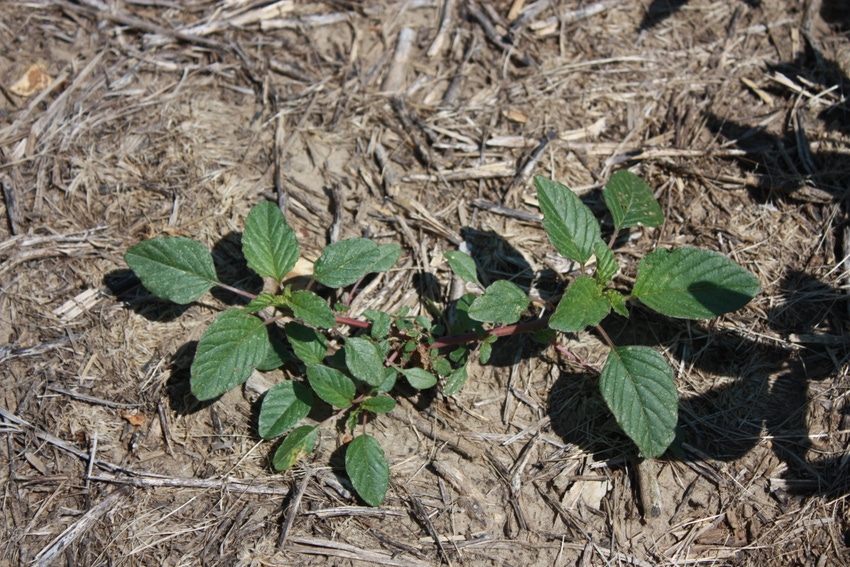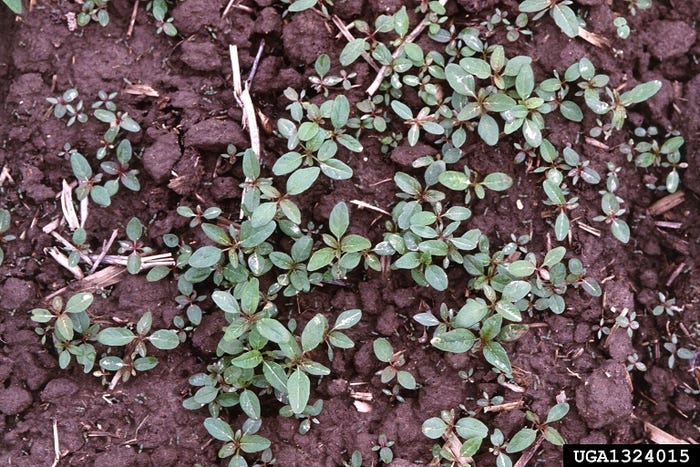April 11, 2018

By Syngenta technical leads and university agronomists
As a longtime leader in weed resistance education, Syngenta believes university and industry research has cast doubt on common assumptions and is rewriting some of the “rules” for managing resistant weeds. Syngenta, along with a university research team, suggests two key strategies for managing herbicide-resistant weeds:
1. Use multiple, effective modes of action (MOAs) every year — ideally, in every herbicide application.
A University of Illinois study found that consistent use of multiple, effective herbicide MOAs was effective in delaying resistance. Jeff Evans, with the United States Department of Agriculture – Agriculture Research Service and based in Urbana, Illinois, and his research team studied weed management data from 105 central Illinois grain farms from 2004 to 2010. The study evaluated why some fields developed populations of glyphosate-resistant waterhemp and others didn’t.
A field that received an average of 2.5 MOAs per application from 2004 to 2006 was 83 times less likely to produce glyphosate-resistant waterhemp seeds than a field that received 1.5 different MOAs per application.
University of Illinois weed scientist Pat Tranel, who was part of Evans’s research team, said, “Ideally, it is more effective to have multiple MOAs in each application, but it depends on timing and effectiveness.”
Syngenta scientists have developed a computer model that produces similar findings. The model compares the longevity of various herbicide programs in corn and soybean cropping systems.
Dane Bowers, technical product lead for herbicides at Syngenta, stated that weed management programs utilizing three MOAs were able to delay development of resistance by at least 18 years over systems utilizing a single MOA (the model simulates 20 years).
2. Don’t count on herbicide rotation alone to prevent resistance.
While some believe herbicide rotation alone will keep them protected against resistance, the research doesn’t support that.
“Weed seeds don’t necessarily germinate the year after they’re produced. Seeds carrying resistance can lie dormant, then germinate after two years, when they’ll face the same herbicide that failed to control their parent weeds,” Bowers said. “If you’re using just one MOA in those years, then that resistant population is off to the races.”
Growers should account for early-emerging weeds, like giant ragweed, as well as late-emerging weeds, like waterhemp and Palmer amaranth.
Key resistant weed challenges
Waterhemp
Waterhemp, a small-seeded broadleaf weed, can grow as much as 1 inch per day and up to 4 to 12 ft. tall. Producing as many as one million seeds per plant, waterhemp pollen can travel one-half mile or more, and because of the cross-pollination that occurs, resistance spreads.

Joe Wuerffel, research and development scientist at Syngenta, explains that waterhemp is known to germinate as early as March and continue through August. Because of this, it’s imperative to implement a herbicide strategy to control waterhemp and manage future resistance. Overlapping residuals are recommended to improve yields and keep fields weed-free for longer.
“Herbicide resistance in waterhemp is very widespread,” Wuerffel said. “We’ve seen its resistance to six different unique MOAs. We pretty much assume that if you have a waterhemp plant in a field, it’s probably ALS-resistant.”
Marestail
Marestail, also known as horseweed, was one of the first glyphosate-resistant weeds identified in U.S. row crops in 2000, now reported in more than 10 states. Marestail seeds are highly mobile and can easily spread to new areas. This is especially concerning as each plant can produce up to 200,000 seeds and grow up to 6 feet high.
“Once you have a 4-inch horseweed in your soybeans, it becomes a major limiting factor,” stressed Bryan Young, Purdue University weed scientist. “If it’s ALS-resistant, we don’t have those herbicides to use on it. If you’re in a glyphosate system, you don’t have an option unless you go to dicamba- or glufosinate-tolerant soybeans.”
According to the United Soybean Board, marestail populations with evolved resistance to glyphosate and ALS-inhibiting herbicides are widespread, and it is easier to control the weed in the seedling or rosette stage. In addition, it has two primary periods of emergence, late March through June and then late summer through late fall.

"If you don’t get marestail early in the spring with spray, you’ll need a tillage tool to uproot them or cut them out of the ground. Otherwise, they are just there for the rest of the season," said Joe Humes, a soybean, corn and wheat grower in Wyaconda, Missouri. "The most important thing to stress to growers is to not cut rates and watch weed height because the bigger it gets, the harder it is to kill. Some guys want to wait and do it all in one pass, and the weeds just get too big. At a certain point, they can’t be controlled."
Giant Ragweed
Giant ragweed can reach up to 20 feet high, pilfering water, nutrients and sunlight from surrounding corn and soybean plants as it grows. Like other large-seeded broadleaf weeds, it is hard to manage as its seeds germinate deep within the soil profile, shielded from herbicide applications. According to Purdue, giant ragweed can produce more than 5,000 seeds per plant and is often 1 to 5 feet taller than the crop with which it is competing.
Many growers fight to manage giant ragweed in their fields as it has shown resistance to multiple modes of action (MOAs). The Take Action Organization reports giant ragweed resistance to ALS inhibitors first occurred in Indiana, Illinois, Ohio and Iowa in the late 1990s and early 2000s. Furthermore, glyphosate-resistant giant ragweed was first confirmed in the Eastern Soybean Belt and has now been confirmed in 11 states across the Midwest and Southern U.S.

According to Wuerffel, giant ragweed historically has been one of the first weeds to emerge out of the ground and germinate in early March for 30 to 40 days. “But recently, this difficult-to-control weed has extended its germination period to 60 to 90 days in the growing season, resulting in the need for residual herbicides and multiple MOAs,” he says.
Palmer amaranth
Palmer amaranth, a member of the amaranthus (pigweed) family, has a complex lifecycle. The combination of its ability to develop resistance and its extended emergence period makes it especially difficult to control. Known to grow up to 3 inches per day and reach up to 8 feet tall, it can easily overtake corn and soybeans due to its aggressive nature. According to research done at Purdue University, Palmer amaranth can create yield losses up to 91% in corn and 79% in soybeans when left uncontrolled throughout the growing season.
Kevin Bradley, University of Missouri weed scientist, has found that equipment, feed, seed and even aquatic birds such as ducks and geese are responsible for Palmer amaranth seed movement. "We moved a lot of seed around, and it’s well beyond a farmer moving it from field to field,” he said. “Palmer amaranth is quickly moving across a larger geography than we’ve seen with any other resistant weed."

According Wuerffel, Palmer amaranth started out as a southern weed, but has now been reported as far north as Minnesota. However, by combining an integrated weed management program that includes both pre- and post-emergence residual herbicides with complementary cultural practices, such as crop rotation, and starting with clean fields and equipment, growers are able to manage the future spread of this difficult-to-control resistant weed.
“Since Palmer amaranth has shown resistance to a number of different herbicides, it’s critical to not allow the weed to emerge from the soil,” Wuerffel explained. “If that’s not an option, because it is extremely aggressive, it’s important to apply a post-emergence herbicide when the weed is less than 1 inch tall.”
Kochia
As resistant kochia continues to spread across the U.S., Syngenta provides key strategies to best manage the highly adaptable, genetically diverse weed.
There are a number of key characteristics of kochia that make it especially difficult to control. It is tolerant to hot, dry conditions and soils with high salinity. It can produce up to 30,000 seeds per plant, its root system can extend down 15 feet and measure 21 feet in diameter, and the weed itself can grow up to 6 feet high. In addition, herbicide-resistant kochia is rapidly evolving due to short seed life, high genetic diversity and heavy reliance on herbicides for control in minimum- and no-till cropping systems.
“Kochia is highly adaptable and can be found in every state except for Alaska and Florida. It can either self-pollinate or can outcross, which increases genetic diversity,” says Wuerffel. “It is essentially a tumbleweed, which means at the end of the season, kochia will harden and die off at its base. When you have a lot of wind and flat ground, kochia can break and really get moving, spreading seeds and resistance.”
Because of these key challenges, many growers have significant difficulty managing resistant kochia. Many growers have learned that managing kochia is not a one-step process. Wuerffel said Syngenta has some great options to help control kochia in soybeans, corn and cereal crops.
Syngenta solutions
For corn growers, Syngenta offers Acuron and Acuron Flexi pre-emergence herbicides, both containing bicyclopyrone, a herbicide technology, which is designed to complement the other active ingredients in the premix to deliver broader, more consistent control of tough weeds other products are missing. A two-pass system works well in areas where marestail has a strong late-season presence and can include a post-emergence application of Halex GT corn herbicide for an additional mode of action. For the best results, Syngenta recommends applying Halex GT in a tank mix with either atrazine or dicamba.
For soybean growers, Syngenta offers effective weed control solutions, including Boundary 6.5 EC herbicide for pre-emergence marestail control and long-lasting residual.
"There are so many practices that help growers maintain the viability of their herbicide tools," said Dane Bowers, Syngenta herbicide technical product lead. "Crop rotation, cover crops, cultivation and harvest weed seed control are some of the ways to develop a truly diversified program, one that does not depend solely on herbicides. There may be an additional investment up front, but the return on investment is strong over time if we can prevent resistant weeds, like marestail, from developing."
Decades of research and development have put Syngenta at the forefront of introducing herbicides with multiple, effective MOAs and extended residual control to help fight resistance. The Syngenta ResistanceFighter.com program provides education, local recommendations, and a comprehensive herbicide portfolio to help growers and retailers effectively manage resistant weeds in their area.
You May Also Like




